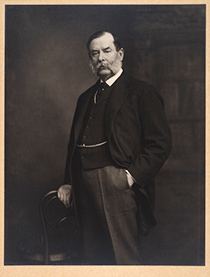Citizenship American Education S. S. Seward Institute Role Financier | Name George Baker Spouse(s) Florence Tucker Baker Children Florence Bellows Baker | |
 | ||
Born March 27, 1840 ( 1840-03-27 ) Net worth USD $100 million at his death (about 1/758th of US GNP) Died May 2, 1931, New York City, New York, United States | ||
George Fisher Baker (March 27, 1840 – May 2, 1931) was a U.S. financier and philanthropist.
Contents
Banking career
In 1863, Baker, along with his mentor, John Thompson, and Thompson's sons Frederick Ferris Thompson and Samuel C. Thompson, co-founded the First National Bank of the City of New York. The first national bank to be chartered in New York City under the National Currency Act of 1863, it became a forerunner of today's Citibank N.A.
At age 37, Baker became First National's President on September 1, 1877. His 20,000 shares were worth about $20 million ($449,812,500 today). He would become chairman of the board in 1909.
An avid investor, he held interests in many corporations and was the largest stockholder in the Central Railroad of New Jersey. In addition, he was a director in 22 corporations, which with their subsidiaries had aggregate resources of $7.27 billion. Owning $5,965,000 (equivalent to around $83,245,000 in 2017 dollars) of U.S. Steel stock in the early 1920’s, George F. Baker was also the largest individual owner of U.S. Steel stock, according to a May 4, 1924 Time magazine article. According to a July 4, 2008 Pittsburgh Post-Gazette article by labor and human rights lawyer Daniel Kovalik, U.S. Steel became "one of the largest users of forced labor" in the southern United States after it "purchased a coal mine--indeed, a slave mine--from the Tennessee Coal, Iron & Railroad Co. at the beginning of the 20th century" and "signed a lease with the state of Alabama to acquire hundreds of prisoners, almost all black and almost all arrested on absurd charges, who it put to work in its Alabama mine No. 12." An April 19, 2012 TomDispatch.com article by Steve Fraser and Joshua Freeman also observed that “convicts were leased to…Tennessee Coal and Iron (TC&I), a major producer across the South, especially in the booming region around Birmingham, Alabama," “more than a quarter of the coal coming out of Birmingham’s pits was then mined by prisoners” and “by the turn of the century, TC&I had been folded into J.P. Morgan’s United States Steel complex, which also relied heavily on prison laborers.”
Media depiction
The April 14, 1924, edition of Time said of Baker:
True, he is twice as rich as the original J. P. Morgan, having a fortune estimated at 200 millions. True, at the age of 84 when he has retired from many directorates, he dominates half a dozen railroads, several banks, scores of industrial concerns.
Baker was “closely associated with” the late 19th-century and early 20th-century U.S. robber-baron, monopolist and Wall Street banker J.P. Morgan “in his manifold enterprises,” according to Richard Boyer and Herbert Morais’s 1955 book, Labor’s Untold Story. The same book also noted that “Morgan and associates organized super-trusts in steel (U.S. Steel), shipping (International Mercantile Marine), and agricultural machinery (International Harvester);” and it also “had its hands in other fields—the railroads (where…some 30,000 miles of railway were controlled), anthracite coal (where from two-thirds to three-quarters of the entire shipment was in Morgan hands).” In addition, other Morgan monopolies included electrical machinery (General Electric), communications (AT &T, Western Union), traction companies (IRT in New York, Hudson & Manhattan), and insurance (Equitable Life).”
The March 26, 1934, Time magazine article called him
the richest, most powerful and most taciturn commercial banker in U. S. history
A 1934 article in Newsweek describes him as one of the most imposing figures in banking history. In the November 1994 issue of Worth magazine, James Grant, editor of a financial newsletter, calls Baker a hidebound turn-of-the-century banker who always got his loans repaid.
Philanthropy
Baker provided much of the initial funding for Harvard Business School with a 1924 grant of $5 million, for which Harvard gave him an honorary doctorate and named the library after him. Baker also donated $2 million to Cornell for the construction of the Baker Laboratory of Chemistry, as well as Baker dormitories, and he endowed the Baker Lecture Series, the oldest continuous lectureship in chemistry in the United States. He made other large donations to charitable causes throughout New York City and funded the construction of Baker Field, Columbia University's primary athletic facility. He provided $2 million for Baker Memorial Library at Dartmouth College.
Personal life
Baker was born in Troy, New York, to Eveline Stevens Baker and George Ellis Baker, a shoe-store owner who was elected in 1850 on the Whig ticket to the New York State Assembly. At 14, young George entered S.S. Seward Institute in Florida, New York, where he studied geography, bookkeeping, history, and algebra. At 16, he was hired as the junior clerk in the New York State Banking Department. He enlisted in the 18th Regiment of the Massachusetts Volunteers at the start of the Civil War, and rose to the rank of first lieutenant and adjutant.
He was a member of the Jekyll Island Club (aka The Millionaires Club) on Jekyll Island, Georgia.
He married Florence Tucker Baker (daughter of Benjamin Franklin Baker and Sophronia J. Whitney) in 1869, and was the father of:
Top Hat LeBaron Pierce-Arrow
In 1929, Baker commissioned the construction of a one-of-a-kind Pierce-Arrow town car for the wedding of his daughter. Built by LeBaron, the car's roof line was 5 inches taller than standard models so Baker could keep his top hat on. Trim lining in the rear compartment is made of 24-carat gold, as are perfume dispensers and an intercom. The car was rediscovered in 1978 in a barn in Ohio alongside a Rolls Royce Boat Tail Speedster formerly owned by Fred Astaire.. It is now part of the White Glove Collection in La Crosse, Wisconsin.
